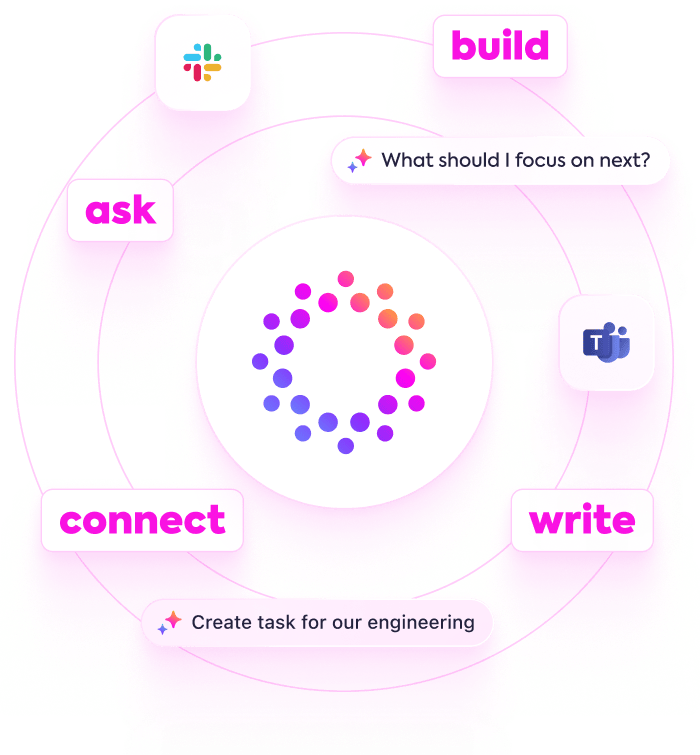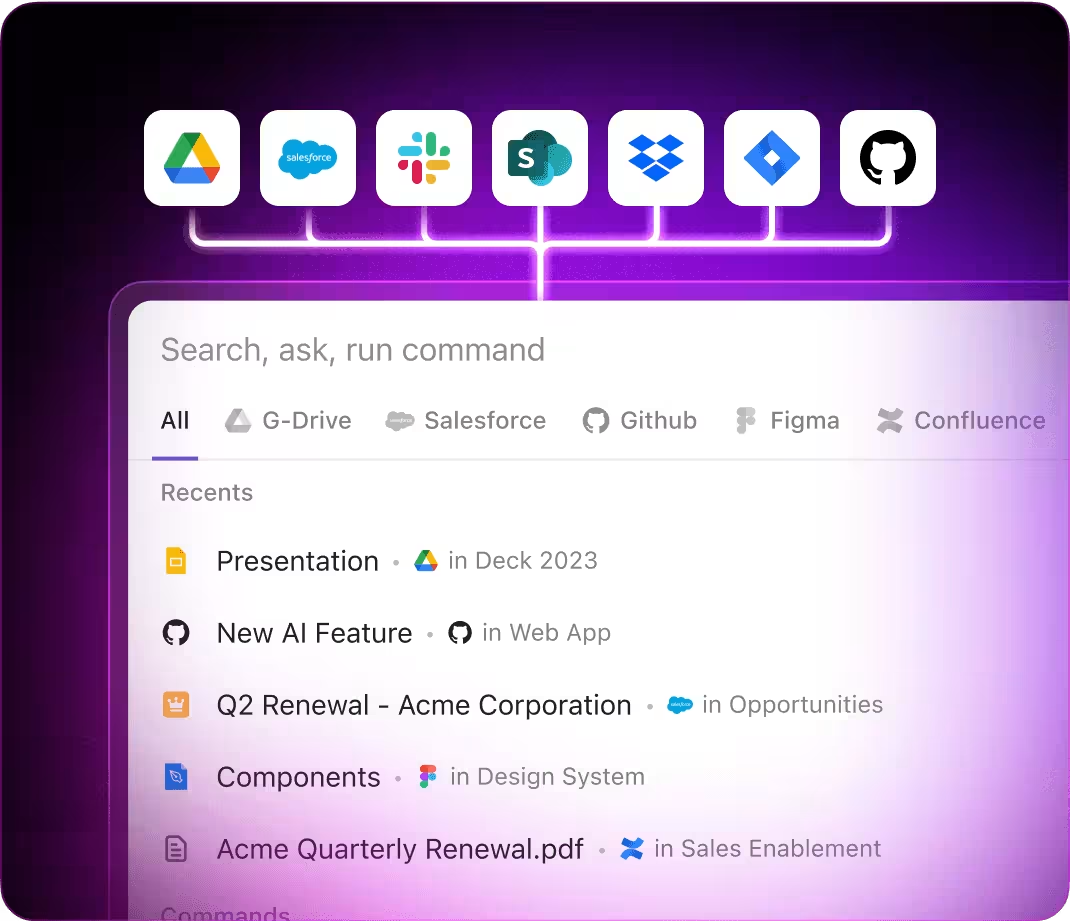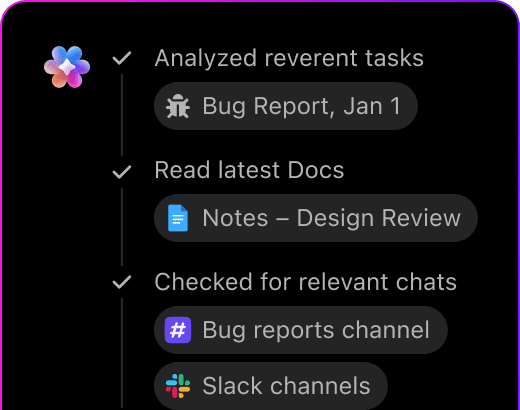AI Technical Specifications
Top AI Prompts for Crafting Technical Specs
Accelerate your specification writing, reduce errors, and elevate your engineering projects using ClickUp AI.

Trusted by the world’s leading businesses
AI Empowering Technical Specs
Revolutionizing Technical Specification Workflows with AI Prompts
Crafting precise technical specifications demands clarity, accuracy, and coordination across teams.
From initial requirement gathering to detailed documentation, compliance validation, and version control, the process involves numerous steps and stakeholders. AI prompts are now a vital tool in managing this complexity.
Technical teams leverage AI to:
- Quickly extract key requirements and standards from vast documents
- Generate detailed spec drafts and validation checklists from brief inputs
- Interpret and summarize regulatory guidelines effectively
- Transform scattered notes into organized outlines, action items, or project milestones
Integrated within familiar environments—such as documents, collaborative boards, and task trackers—AI acts as a proactive partner. In solutions like ClickUp Brain, it seamlessly converts your raw ideas into structured, executable plans.
ClickUp Brain Compared to Conventional Solutions
Discover How ClickUp Brain Elevates Your Workflow
ClickUp Brain integrates seamlessly with your projects, understands your context, and empowers you to act faster without repetitive explanations.
Conventional AI Platforms
- Constantly toggling between multiple apps to collect details
- Reiterating your objectives with every query
- Receiving generic, irrelevant feedback
- Hunting through numerous platforms to locate a single document
- Interacting with AI that only processes input passively
- Manually switching among various AI engines
- Merely an add-on in your browser
ClickUp Brain
- Deeply connected to your tasks, specifications, and team communications
- Retains your project history and objectives
- Provides insightful, context-driven guidance
- Searches all your resources in one place
- Supports voice commands with Talk to Text
- Automatically selects the optimal AI model: GPT, Claude, Gemini
- Dedicated desktop app for Mac & Windows designed for efficiency
Technical Specification Prompts
15 Essential AI Prompts for Technical Specifications (Validated in ClickUp Brain)
Accelerate your specs creation—clarify requirements, validate standards, and enhance collaboration effortlessly.

Identify 5 design approaches for a compact electric SUV’s exterior, based on insights from the ‘Spring 2025 Concept’ document.
Use Case: Speeds up design brainstorming by leveraging existing concept references.
ClickUp Brain Behaviour: Analyzes linked documents to extract design themes and suggests fresh exterior concepts.

What are the current interior layout trends for sub-$25K EVs in the North American market?
Use case: Informs cost-effective interior design choices with up-to-date market data.
ClickUp Brain Behaviour: Aggregates findings from internal research files; Brain Max can supplement with relevant external data if accessible.

Draft a design brief for a minimalist dashboard inspired by Scandinavian design principles, referencing Sketch File #8 and prior concept notes.
Use Case: Ensures unified direction for design and UX teams through structured documentation.
ClickUp Brain Behaviour: Extracts pertinent notes and textual data from linked files to compile a comprehensive design brief.

Summarize front suspension performance benchmarks comparing Tesla Model Y and VW ID.4 using the ‘Suspension Q2’ report.
Use Case: Facilitates quick comparative analysis without manual data review.
ClickUp Brain Behaviour: Pulls tabular and narrative data from internal docs to generate a concise comparison summary.

List leading thermal management materials used in high-performance EVs, referencing R&D notes and supplier specifications.
Use Case: Supports material selection for effective cooling solutions.
ClickUp Brain Behavior: Scans internal documents to identify common materials and associated performance characteristics.

From the ‘Steering System Validation’ document, generate a DVP&R-style checklist for component testing.
Use Case: Simplifies test planning by automating checklist creation.
ClickUp Brain Behavior: Extracts test criteria and formats them into a structured checklist within a task or document.

Summarize 3 emerging gesture control trends in infotainment UX from post-2024 user research and technology review documents.
Use Case: Keeps interface designs innovative and grounded in user research.
ClickUp Brain Behavior: Identifies recurring patterns and insights from linked research materials.

From the ‘Gen Z UX Survey Q1’ document, summarize key preferences for in-car app interfaces.
Use Case: Aligns infotainment and mobile integration designs with youth user behaviors.
ClickUp Brain Behavior: Analyzes survey data to highlight common design themes and feedback.

Compose concise and engaging UX copy for the eco-mode toggle screen, following the tone guidelines in ‘ProductTone.pdf.’
Use Case: Accelerates UI text development while maintaining brand voice.
ClickUp Brain Behavior: References tone and style guides to propose varied interface copy options.

Summarize key updates in EU 2025 pedestrian safety regulations and their implications for fascia design.
Use Case: Guides design adjustments to meet evolving compliance standards.
ClickUp Brain Behavior: Extracts and condenses information from internal compliance documents; Brain Max can include public updates if available.

Generate placement and dimension guidelines for EV charging indicators, referencing India-specific compliance documents within the workspace.
Use Case: Ensures product features meet regional regulatory requirements.
ClickUp Brain Behavior: Pulls measurements, positioning rules, and notes from internal files to create a compliance checklist.

Create a frontal crash-test checklist using US NCAP 2025 PDFs and chassis design documents.
Use Case: Supports QA teams in verifying safety design compliance.
ClickUp Brain Behavior: Extracts requirements from PDFs and organizes tasks by test area and severity level.

Compare interior sustainability features, such as recycled materials, across Tesla, Lucid, and Rivian using competitive analysis documents.
Use Case: Informs design benchmarking and sustainability roadmap planning.
ClickUp Brain Behavior: Summarizes documented comparisons into clear, digestible formats like briefs or tables.

What interior design trends have emerged in autonomous vehicles since 2023?
Use Case: Provides R&D teams with forward-looking insights based on evolving user experience research.
ClickUp Brain Behavior: Synthesizes trends from internal notes, concept summaries, and uploaded reports.

Summarize key cabin usability challenges from Southeast Asia EV feedback (materials, layout, interactions).
Use Case: Drives region-specific product enhancements based on user feedback.
ClickUp Brain Behavior: Extracts and prioritizes user-reported issues from surveys, feedback notes, and tagged tickets.
Accelerate Technical Specs Creation with ClickUp Brain
Cut down revisions, unify your team’s efforts, and produce precise technical documents using AI-driven processes.






AI Applications
Leading AI Applications in Technical Specification Development
Speed up specification drafting, enhance precision, and discover innovative approaches with AI assistance
From Concepts to Clear Specs
Initial technical specs usually start as fragmented thoughts and incomplete outlines. ClickUp Brain organizes these fragments into detailed, accessible specification documents—right within ClickUp Docs.
Leverage ClickUp Brain to:
- Convert preliminary notes into comprehensive spec templates
- Produce fresh technical details informed by previous project data (using context-sensitive AI writing)
- With Brain Max, instantly explore prior product specs, test results, and engineering notes to inspire your next design phase.

From Design Concepts to Engineering Execution
Engineers often navigate through complex notes and detailed reviews. ClickUp Brain empowers you to pinpoint key tasks, identify potential challenges, and craft precise follow-ups from this information.
Leverage ClickUp Brain to:
- Condense in-depth technical conversations within tasks or Docs
- Convert detailed design annotations into actionable engineering assignments
- Automatically generate issue logs or transition summaries
- With Brain Max, effortlessly retrieve past decisions, component analyses, or project discussions throughout your workspace—eliminating the need to sift through extensive CAD documentation.

Technical Specifications with ClickUp Brain
Crafting detailed technical specifications involves managing complex requirements, stakeholder input, and version control. ClickUp Brain simplifies this process by extracting key points and drafting precise documentation aligned with your standards.
Leverage ClickUp Brain to:
- Analyze meeting notes and distill critical specs
- Produce clear, consistent technical descriptions for components
- Convert review comments into actionable revision tasks
- Brain Max enhances this by providing quick access to previous spec versions or related project documents, supporting continuity throughout extensive development phases.

AI Advantages
How AI Prompts Revolutionize Technical Specification Processes
Implementing AI-driven prompt systems enhances every phase of your specification workflow:
- Accelerate drafting: Transform initial concepts into detailed specs, templates, and checklists swiftly
- Minimize errors: Detect discrepancies by cross-referencing previous versions and stakeholder feedback
- Align your team: AI-crafted summaries and reports ensure everyone stays informed and coordinated
- Make informed choices: Generate insights on regulatory standards and market requirements through targeted prompts
- Innovate confidently: Investigate advanced solutions beyond current technical constraints.
Each output integrates directly within ClickUp, turning your AI-generated content into actionable documents, tasks, and visual dashboards that drive your projects ahead.
Prompt Guidance
Crafting Effective Prompts for Technical Specs
Clear prompts unlock precise specifications.

Define the technical scope clearly
Vague prompts yield broad results. Specify details such as component type (e.g., “battery module” or “chassis frame”), performance targets (e.g., “high durability” or “lightweight design”), or compliance standards (e.g., “ISO 26262” or “RoHS”).
Example: “Outline thermal management requirements for a lithium-ion battery pack in electric vehicles.”

Use side-by-side comparisons for clarity
AI excels at contrasting specifications. Use prompts like “compare X and Y” to assess material options, manufacturing methods, or regulatory compliance.
Example: “Compare tensile strength and cost between aluminum alloy 6061 and carbon fiber composites.”

Frame prompts around engineering objectives
Approach prompts as specific engineering challenges. Instead of “Generate specs,” focus on the intended function:
Example: “Develop mounting bracket specifications for a compact motor ensuring vibration resistance and ease of assembly.”

Specify desired output format
Need a specification sheet, checklist, or test plan? Indicate it explicitly. AI delivers better when the output format is clear.
Example: “Provide a bullet-point list of quality control tests for automotive wiring harnesses with acceptance criteria.”
Accelerate Technical Specs Creation with ClickUp Brain
ClickUp Brain goes beyond managing tasks—it's your expert partner throughout the technical specification development process.





